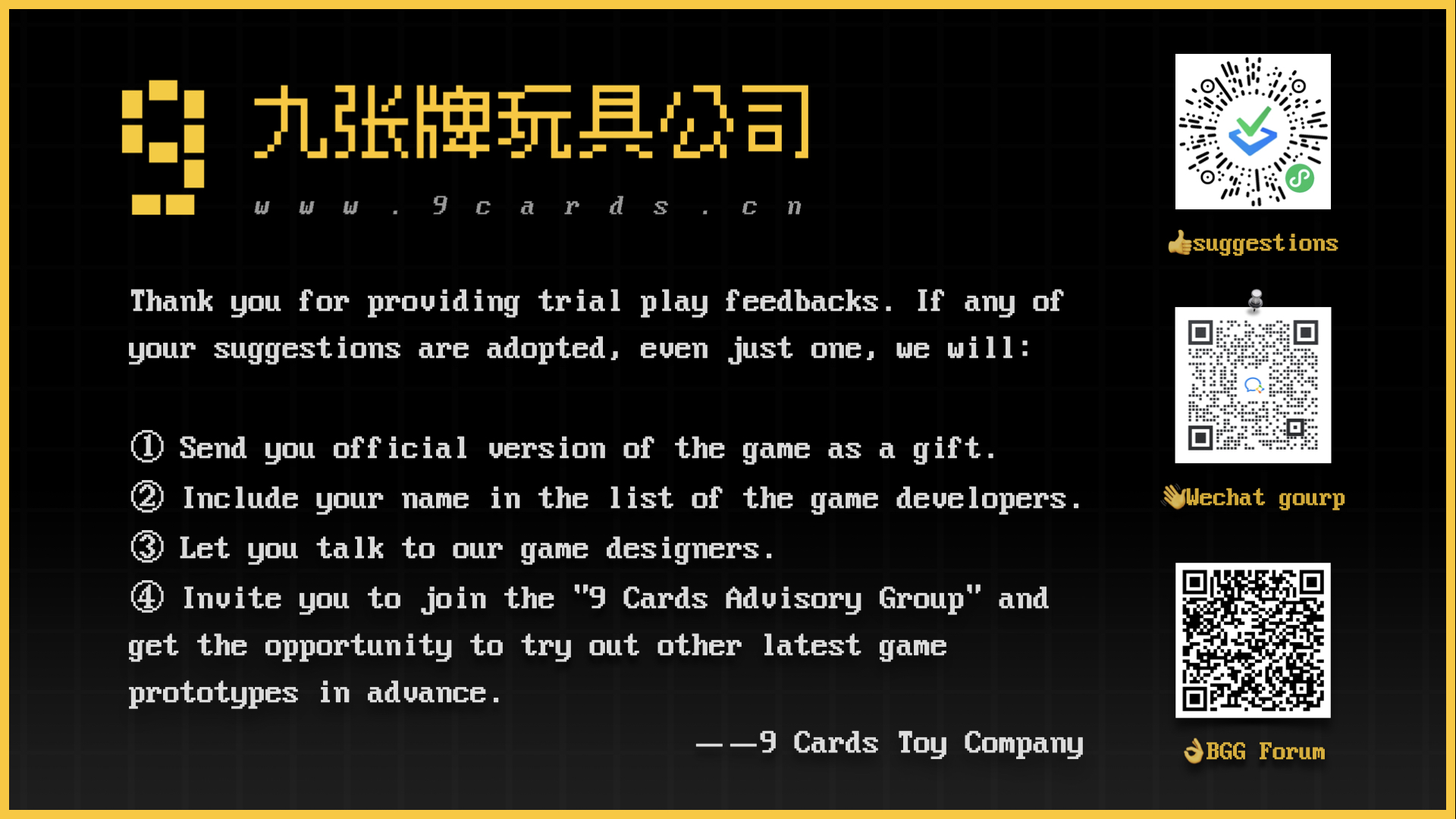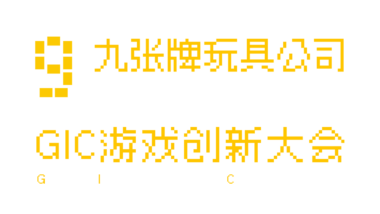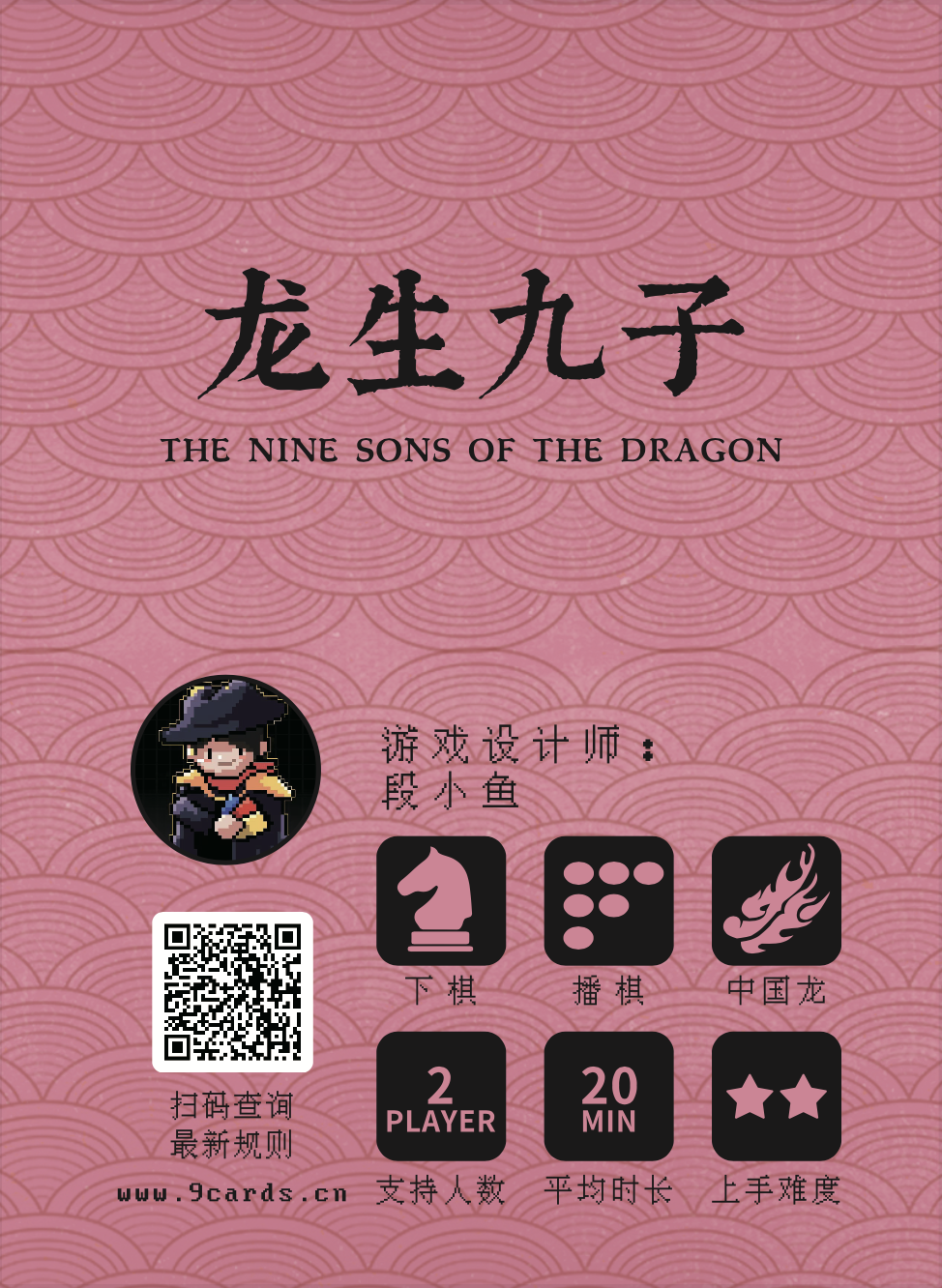
▋Game Introduction
As the old saying goes: A dragon have nine sons, but each one is different. They have different natures. There is a rumor in the clan that the one who tames the most dragon sons will gain the power of the dragon and lead the clan to prosperity. But all this is by no means easy. Although some dragon sons are docile and approachable, there are also fierce and difficult to tame, eccentric ones that need to be catered to and managed slowly. Now that the nine dragon sons have appeared in the world, as a candidate for the clan leader, are you ready?
“The Nine Sons of The Dragon ” is a chess game that supports 2 players and uses mancala as the main mechanism. In this game, both players take turns to place or move chess pieces, and tame the dragon card by stacking 3 chess pieces in the same grid. Reasonably use the opponent’s chess pieces and the characteristics of the dragon, and the player who gets more points will become the winner.
▋Game Component
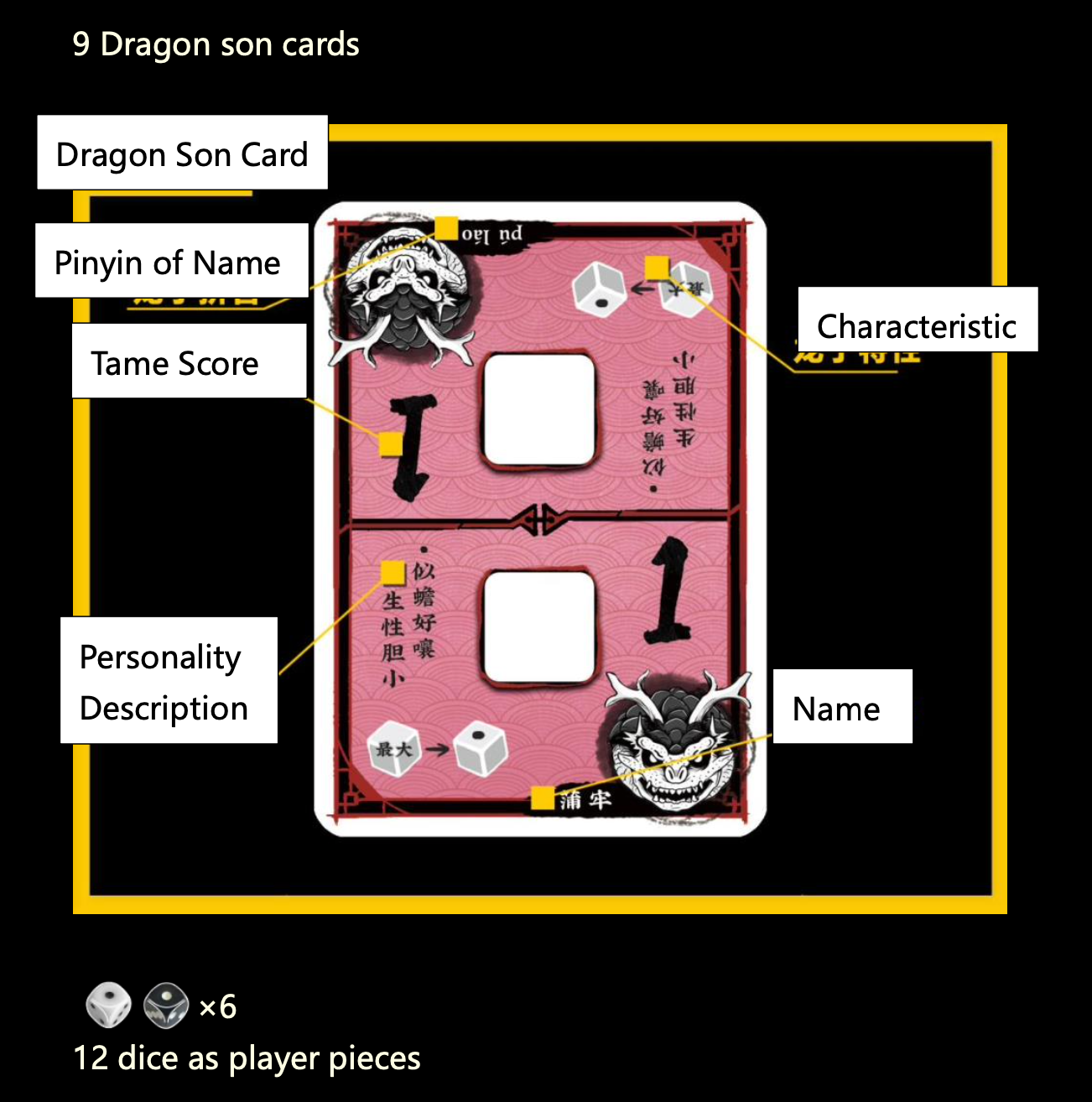
▋Game Setup
①Each player takes 6 dice of the same color and adjusts the points to 1, 2, 3, 4, 5, and 6. Normally, the points on this dice cannot be changed.
②Shuffle the 9 Dragon Son Cards randomly and place them face down aside. Draw out 6 cards and place them face up to form a 3×2 rectangular chessboard.
③ The player whose zodiac sign is closest to the dragon becomes the first player.

▋Gameplay
Chessboard and Grid
▶ The chessboard consists of 3×4 , totaling 12 grids. Each card is considered to have 2 grids. Grids that are adjacent in the horizontal and vertical directions are considered adjacent.
▶ A grid can hold up to 3 dice, and these dice must be stacked up from bottom to top in the order they enter the grid. The topmost dice in the grid is called the top dice.
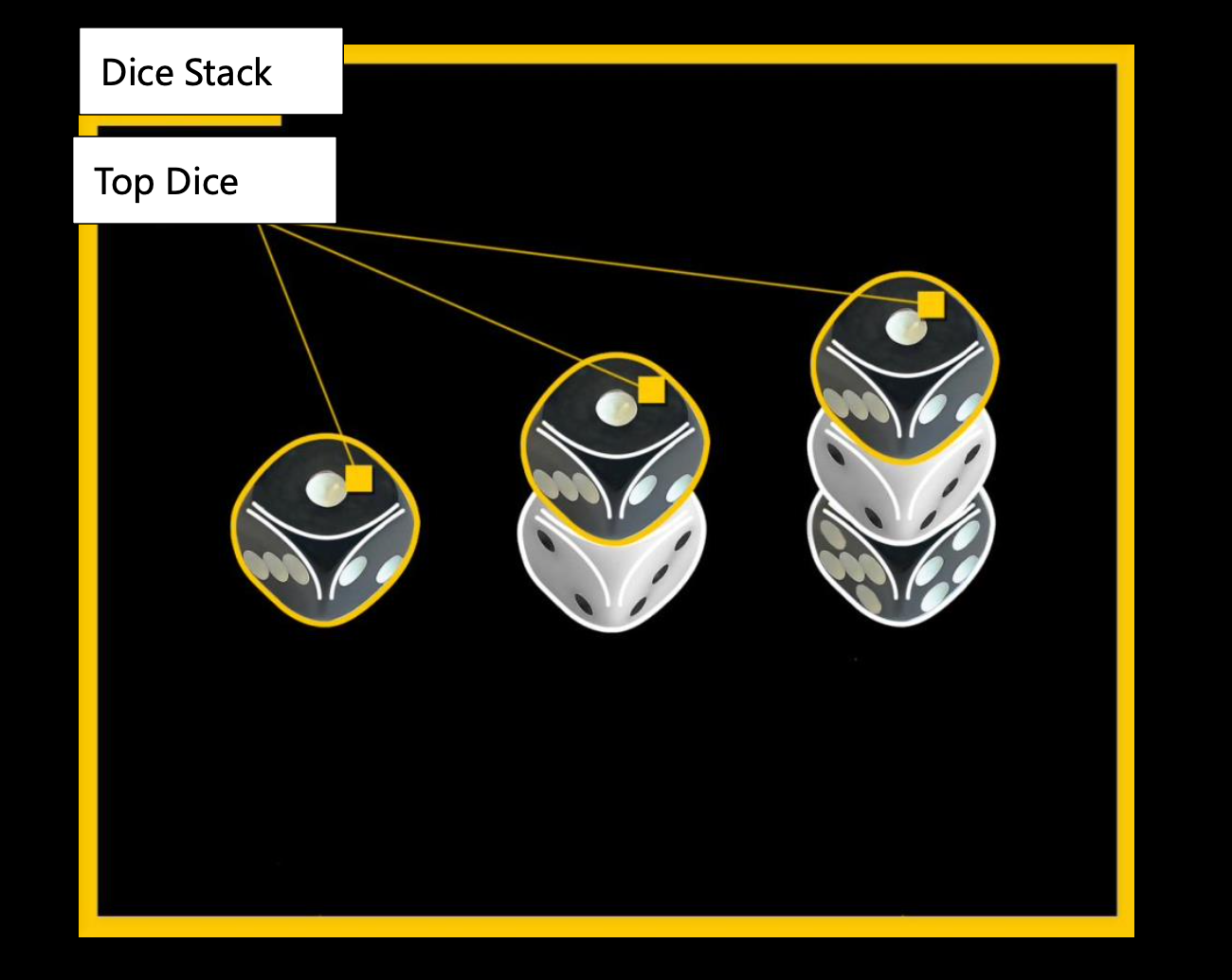
Play
The game will start with the first player taking turns to act. When taking an action, choose 1 of the following operations to perform:
▶Place a dice outside your play area in a blank grid on the board.
▶Move a group of dice on the field.
When one player has completed his action, it is his opponent’s turn to act. Take turns to act until trigger the game end.
Move Action
▶ When a player performs a move action, he chooses one of his top dice and takes all the dice in that grid into his hand, but does not change their stacking order.
▶ You must move as many grids as dice you have in your hand. Each time you move one grid, you leave the bottom dice in your hand in the gird after the move.
▶ Each time a dice moves, it can only move to adjacent grid and follow the following rules:
▞ If a grid is empty, the dice can move to it.
▞ If there are 3 dice on a grid, the dice cannot be moved to it.
▞ If there are 1 or 2 dice in a grid, compare the points of the top dice in your hand with the top dice in the grid. If the points of the top dice in your hand are greater than or equal to the top dice in the target grid, you can move to it; otherwise, you cannot move to it. Notice: When comparing the points of top dice, 1 is considered greater than 6, and 6 is considered less than 1.
▞ In a move action, the player cannot move to a grid that has already been moved or started to move, and must complete all the steps. If the player cannot do this, the move action cannot be selected.
Taming the Dragon son
▶ After the player takes action, check if there is a grid with 3 dice stacked on it. If so, the top dice on that grid tames the dragon son card.
Notice: Some dragon son cards need to meet additional conditions before they can be tamed, see,The difference between dragon sons.
▶ When the player’s top dice tames the dragon son card, he takes the card in front of him and returns all dice on the card to their owners. The returned dice can continue to be used.
▶ Turn over a new dragon son card from the deck and place it where the tamed dragon son card was to fill the empty space. If the deck is empty at this time, ignore this step.
▶ If multiple dragon son cards are tamed after a move, the above process is settled for each card in turn. The settlement order is determined by the current player.
▶ If two players meet the taming requirements of the same dragon son card at the same time, the player in the current round will decide which player tames the dragon.
The difference between dragon sons.
The green dragon son has a docile personality and can be tamed as long as there are 3 dice stacked in one grid of its card. There are no additional requirements.
The yellow dragon has a peculiar personality and requires players to meet special conditions in order to tame it.
▶ 狻猊SuanNi When you are about to tame this card, check if there are only 3 dice on this card. If not, it cannot be tamed.
▶ 霸下BaXia When you are about to tame this card, check if there are ≥ 4 dice placed on this card. If not, it cannot be tamed.
▶ 嘲风 ChaoFeng When you are about to tame this card, check if the top dice is 5 or 6. If not, it cannot be tamed.
The red dragon sons have a ferocious personality, and players will trigger some negative effects after taming it.
▶ 蒲牢PuLao After taming this card, all your dice in this card will be permanently changed to 1.
▶ 睚眦YaZi The player who tames this card will receive negative points.
▶ 螭吻 ChiWenThe top dice that tamed this card is removed and cannot be used again in this game.
▋Game End
The game ends immediately when there are only 4 dragon son cards left on the board or a player gets 7 points.
Players add up the total points of their dragon cards, and the player with the higher score wins the game; if the scores are the same, the player with the most dragon son cards wins.
▋FAQ
Q:What to do if a player is unable to act?
A:The game ends immediately. The player loses the game and his opponent wins the game.
Q:How to settle the game when there are only 4 cards left on the chessboard but there are still tames unfinished?
A:The game ends as soon as there are 4 cards left on the board. If there are 5 dragon cards left and a player tames 2 dragon cards at the same time, the game ends and the winner is determined when one of them is settled.
Q:What should we do if players do repeatedly moves?
A: When the same situation appears three or more times on the board after a player’s move, the game ends immediately and the winner is determined according to the rules of normal ending. If the player’s score and the number of tamed dragons are the same, it is considered a draw.
